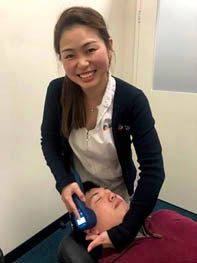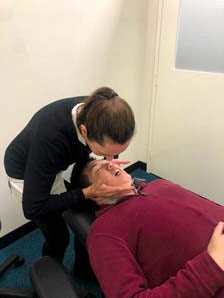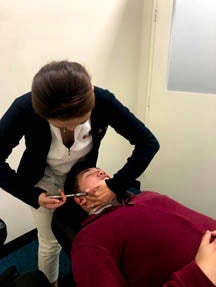 The temporomandibular joint (TMJ-Jaw) connects the lower jaw to the skull and is often the cause of jaw pain and headaches in many individuals. Temporomandibular disorder (TMD) is a broad term which encompasses all disorders affecting the Jaw.
The temporomandibular joint (TMJ-Jaw) connects the lower jaw to the skull and is often the cause of jaw pain and headaches in many individuals. Temporomandibular disorder (TMD) is a broad term which encompasses all disorders affecting the Jaw.
Causes of TMJ Pain
- Inflammation of the Jaw joint
Inflammation within the TMJ can be a result of a number of things including a direct blow to the jaw joint, whiplash injuries indirectly affecting the Jaw, heavy chewing, clenching due to stress, grinding your teeth at night or a loss of dental height due to missing teeth or wearing down of teeth. This inflammation may then lead to pain and dysfunction of the joint.
- Internal derangement of the joint
Internal derangement describes TMJ conditions in which there has been structural changes within the joint. This can be caused by a direct blow to the joint, whiplash injuries, clenching or grinding teeth or prolonged periods of having the mouth wide open during long dental procedures under anaesthesia.
Internal derangement of the TMJ often results in an audible click or pop heard when opening the mouth and you may also see deviation of the jaw to one side when opening and closing the mouth. In severe cases, you may even experience lockjaw – the painful locking of the jaw which results in an inability to close the mouth.
- Degeneration
Degenerative arthritis can be seen in the TMJ- jaw joint in individuals over the age of 50 or in younger individuals who have previously had an injury to the TMJ.
- Extra-articular Causes
This refers to causes of TMJ pain which do not occur in the joint but rather around the joint. Some of these causes include:
- MUSCULAR SPASM
There are a number of muscles attaching around the TMJ which help with chewing. If these muscles become particularly tight and spasm, it can cause a significant amount of pain and potentially reduced range of motion. Causes of spasm and tightness in these muscles include clenching for long periods of time, stress and prolonged dental or aesthetic procedures.
- POSTURAL IMBALANCE
Poor neck posture with the head sitting in a protruded position causes strain through muscles in the neck putting unnecessary force through the lower jaw. This can eventually lead to inflammation, pain and early degeneration of the TMJ- jaw joint.
Do I have Temporomandibular Disorder?
 If you:
If you:
- Can feel tightness, muscle spasm or either increased or decreased range of motion in your TMJ,
- Notice deviation of your jaw to one side when you open or close your mouth,
- Tend to chew your food on only one side,
- Have been told that you grind your teeth in your sleep,
- Have been told by your dentist that your teeth are particularly ground down due to clenching or grinding your teeth,
- Experience a headache which you think may be associated with the pain in your jaw or,
- Have noticed indentations in your tongue or cheek which indicates that you have been clenching your teeth
You may have TMJ dysfunction which has ultimately led to chronic Jaw pain.
How do you Treat Temporomandibular Disorder?
The correct assessment and diagnosis of TMJ disorders is important in providing appropriate treatment. With the appropriate care, patients may report a significant improvement in pain within 3 – 6 weeks. A study conducted in 2015 [1] assessed the different types of treatment styles and their effectiveness in the treatment of Jaw pain. Common treatment approaches for TM-Jaw pain include, but are not limited to:
- SOFT TISSUE TREATMENT
Manual massage is often used to treat tight muscles in the area. This can include intraoral trigger point therapy of the pterygoid muscle.
- MANUAL THERAPY
Your chiropractor may mobilise or manipulate the TMJ in order to assist in restoring the natural range of motion and resting position of the joint.
- OCCLUSAL SPLINTS
Occlusal splints are custom made and removable dental mouthguards which aim to protect the teeth, TMJ and muscles from overuse in the case of individuals who may grind or clench their teeth. Your chiropractor may recommend you see your dentist for advice about the use of an occlusal splint when sleeping.
- POSTURAL CORRECTION
Protrusion of the head may contribute to TMJ pain due to added strain through the lower jaw. This is commonly due to a musculature imbalance where there is tightness of muscles at the front of the neck and weakness in the muscles at the back of the neck. Chiropractic adjustments and postural advice may help to correct posture and minimise the strain through the TMJ’s. For more information about upper cross syndrome, see out previous blog “Poor Posture Upper and Lower Crossed Syndrome” (posted March 12 2020).
- MANAGEMENT STRATEGIES AND ADVICE
Your chiropractor will help you identify the root cause of your TMJ pain and help you correct any dysfunctions. Your chiropractor may recommend strengthening exercises and stretches or suggest you visit your dentist.
 If you have noticed any pain in your jaw or headaches that you think may be associated with jaw pain or tension, our chiropractors at Lakeside Chiropractic may be able to assist you. Lakeside Chiropractic is central to Perth’s northern suburbs in Joondalup including Kingsley, Woodvale, Heathridge, Yanchep, Clarkson, Jindalee, Leederville, Mullaloo, Sorrento, Padbury, Currambine and Hillary’s and is located in the centre of Joondalup on 3/45 Central Walk.
If you have noticed any pain in your jaw or headaches that you think may be associated with jaw pain or tension, our chiropractors at Lakeside Chiropractic may be able to assist you. Lakeside Chiropractic is central to Perth’s northern suburbs in Joondalup including Kingsley, Woodvale, Heathridge, Yanchep, Clarkson, Jindalee, Leederville, Mullaloo, Sorrento, Padbury, Currambine and Hillary’s and is located in the centre of Joondalup on 3/45 Central Walk.
We have a HICAPS terminal on site which means you can claim direct from your health fund on the day of your treatment. We are a Medibank and BUPA preferred provider but we are also able to process claims from HBF, HIF, CU Health, health.com.au, ahm, Defence and Australian Unity Health. If your fund is not listed, please feel free to ask one of our friendly staff members. Here at Lakeside Chiropractic our staff are fully trained and regularly see visitors who they are able to successfully treat and improve posture and jaw pain. Please call us on 9300 0095 or on the website www.lakesidechiro.com.au via the Book Online Now tab.
References
1. Calixtre LB, Moreira RF, Franchini GH, Alburquerque-Sendín F, Oliveira AB. Manual therapy for the management of pain and limited range of motion in subjects with signs and symptoms of temporomandibular disorder: a systematic review of randomised controlled trials. J Oral Rehabil. 2015 Nov;42(11):847-61. doi: 10.1111/joor.12321. Epub 2015 Jun 7. PMID: 26059857.
Schedule an Appointment


 The temporomandibular joint (TMJ-Jaw) connects the lower jaw to the skull and is often the cause of jaw pain and headaches in many individuals. Temporomandibular disorder (TMD) is a broad term which encompasses all disorders affecting the Jaw.
The temporomandibular joint (TMJ-Jaw) connects the lower jaw to the skull and is often the cause of jaw pain and headaches in many individuals. Temporomandibular disorder (TMD) is a broad term which encompasses all disorders affecting the Jaw. If you:
If you: If you have noticed any pain in your jaw or headaches that you think may be associated with jaw pain or tension, our chiropractors at Lakeside Chiropractic may be able to assist you. Lakeside Chiropractic is central to Perth’s northern suburbs in Joondalup including Kingsley, Woodvale, Heathridge, Yanchep, Clarkson, Jindalee, Leederville, Mullaloo, Sorrento, Padbury, Currambine and Hillary’s and is located in the centre of Joondalup on 3/45 Central Walk.
If you have noticed any pain in your jaw or headaches that you think may be associated with jaw pain or tension, our chiropractors at Lakeside Chiropractic may be able to assist you. Lakeside Chiropractic is central to Perth’s northern suburbs in Joondalup including Kingsley, Woodvale, Heathridge, Yanchep, Clarkson, Jindalee, Leederville, Mullaloo, Sorrento, Padbury, Currambine and Hillary’s and is located in the centre of Joondalup on 3/45 Central Walk.